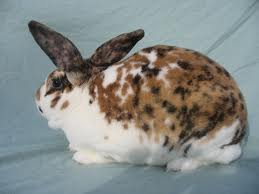Type the name of the breed you're looking for below
[wpdreams_ajaxsearchlite] Don't see the breed your're looking for? Click here and let us know!
Breed Characteristics
1 paw - breed exhibits the least amount of this characteristic
5 paws - breed exhibits most amount of this characteristic
Rhinelander rabbit
| Origin | The Rhinelander first appeared in shows in 1902 in Germany, after initially being bred in North Rhine-Westphalia. They were developed from a cross between a Harlequin buck and a gray doe of unknown breeding. A buck from the litter had the markings that the Rhinelander would come to be known for - black and orange in colour, located on the chin, ears and "butterfly markings" in black on one side and orange on the other. Another cross was made between the Harlequin buck and a Checkered Giant doe, with the resulting litter producing a doe with the desired markings. The buck from the first litter and the doe from the second litter were mated, and does from the resulting litters were crossed with Harlequin bucks to create the Rhinelander breed. In 1905, a German breed standard was created, and they were given the German name "Rheinishe Schecke". In 1924, the first rabbits were exported to the Netherlands and England. Although initially very popular, the initial interest soon dwindled, along with breeder numbers. Selective breeding for colour markings, as required by the breed standard, was beyond the skill of many breeders; this, combined with the athletic, rather than meat-producing, conformation, resulted by 1930 in only a few breeders continuing to preserve the breed. Interest re-emerged in post-World War II Germany, however, and population numbers again grew, with the Rhinelander becoming the most popular spotted breed in the country by 1978. After the first exports from Germany to the US in 1923, the Rhinelander was recognized as a breed in the US by the National Breeders and Fanciers Association. By 1932, however, none remained in the US, likely due either to the difficulties of meeting the breed standard or to greater breeder interest in the Checkered Giant rabbit. In 1972, an American breeder visiting West Germany saw the breed at a show and returned to the US with four Rhinelanders. In 1974, the Rhinelander Rabbit Club of America was created, and in 1975, the breed was acknowledged by the American Rabbit Breeders Association. Over the next two decades, additional animals were imported from the Netherlands and Germany to combat problems with inbreeding among the limited population in the US. Some breeders crossed Rhinelanders with Harlequin or Checkered Giant rabbits to improve the stock. In 1994, the American breed standard was rewritten and clarified, and interest in the breed continued to grow. The American Livestock Breeds Conservancy places the breed at "watch" status, meaning they have a global population of less than 2,000 and less than 200 registrations in the US each year. The Rhinelander is recognized by the British Rabbit Council and the American Rabbit Breeders Association. In Britain, the Rhinelander is grouped with other rare rabbit breeds in the Rare Varieties Club. |
Physical Attributes
| Weight | 6.5 - 10 lbs. (2.9 - 4.5 kg) |
| Ear Type | Erect |
| Fur Type | Flyback |
| Colours | This is a tricoloured rabbit with with spots of black and orange. |
| Appearance | It has a rather racy body with a narrow head and long upright ears. |
| Other Considerations | Life Expectancy: 5 - 8 years Temperament: Gentle and alert |
| Best Kept In | Pen. Cage, House or Yard. |



